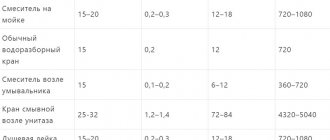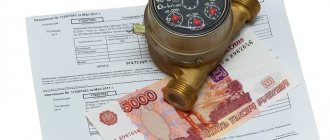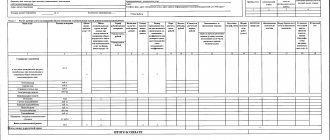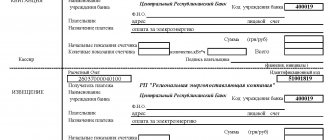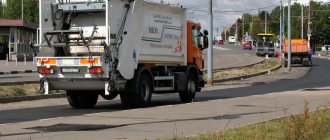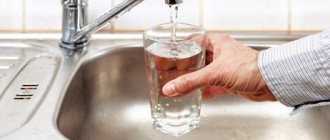In residential premises, if technically possible, special devices must be installed that take into account the consumption of water and energy resources. In addition to individual meters directly in apartments, it is necessary to install communal meters. This measure encourages residents to save on expensive services. There are standards and regional tariffs for utilities. In the case where homeowners have not installed metering devices, a multiplying factor (abbreviated as PC) is applied to the calculation of consumption.
What is a multiplying factor and its use in the absence of metering devices
The increasing factor is a certain numerical value by which the tariff for the provided utility service will be multiplied in the event of non-compliance with the requirements of the regulatory act, namely the absence of a meter.
The value of the coefficient is established by law and serves as a penalty for those who violate the implementation of acts on the mandatory installation of metering devices.
Is it possible to avoid tariff increases without installing meters?
It is possible if the use of devices is impossible for the following reasons:
- housing is recognized as unsafe or dilapidated;
- installation requires network repair;
- pipes or wiring are faulty;
- if the environmental conditions are not suitable for operating the meter (humidity, temperature, electromagnetic radiation).
Metering devices are applied to public services:
- hot water supply;
- cold water supply;
- heat supply;
- electricity.
Meters record the actual consumption of the above categories; payment for utilities is made on the basis of this data.
Until recently, installing meters was not very profitable, because in fact, more people could live in the apartment, and the fee was charged to those registered at the average rate. Since 2014, based on new regulations, the authorities began to apply increasing coefficients if residents do not provide accurate data.
It is important to know! The application of the increasing coefficient is possible only to property owners. In other cases, the municipality or landlord is responsible.
The coefficient comes into effect:
- if devices for recording the consumption of cold water, hot water, heating, electricity are not installed;
- if 3 months have passed since the device broke down, it has not been repaired or replaced;
- or if the owner does not confirm the accuracy of the information and does not allow a housing and communal services specialist to inspect it.
Important! The coefficient has been calculated since 2020 and is steadily growing. So, in 2020 it was 1.1, and from January 1, 2020, 1.6. However, it was later adjusted to 1.5. This means that today the additional payment at the current tariff is 50% . However, there are no plans to raise the coefficient in 2020. In the payment document, the RSO coefficient must be indicated in a separate line, and the basic standard must be indicated next to it.
Justification for using the increasing factor
According to specialized commissions under the Government of the Russian Federation, the existing socio-economic situation in each region is pushing cold water suppliers to take measures to increase tariffs for their services. Inflationary growth of the economy affects the components of the water tariff, although the burden of paying for utilities is very high for the population.
The cost of payment for cold water includes the cost of modernization and ongoing repairs of supply networks. An increase in prices for metallurgical products and electricity entails either a decrease in the volume of work carried out on cold water supply networks, or an increase in the tariff schedule for water supply services.
The deterioration of the networks and equipment of most enterprises does not allow reducing the number of repairs. Since this will affect the quality of drinking water, which affects the health of citizens and must comply with [2] SanPin 2.1.4.1074.1 “Drinking water”.
The amount of water consumed by the population also plays a large role in the share of the cost of the service. Unaccounted resource consumption greatly affects the economic indicators of the cost of the tariff. Since a larger amount of water requires greater costs for its extraction, bringing it to appropriate sanitary indicators and delivering it to the consumer.
By installing cold and hot water consumption meters, citizens strive to save natural resources. To cover the uneven unmetered water consumption compared to the amount of recorded consumption in 2020, an increasing coefficient was introduced for citizens who do not have an individual meter in their apartment.
Increasing coefficient for heating
In addition to intra-apartment measuring devices, the management company is obliged to install general devices that measure heat consumption in apartment buildings. If there is metering equipment, residents pay for heat energy not according to the standard, but according to the fact of consumption.
At the end of February 2020, the heating PC was reduced from size 1.5 to 1.1. This is due to the procedure for using funds, which the utility company now has the right to dispose of independently. In 2020, the coefficient remains at 1.1.
The coefficient applies only to apartment owners and legal entities in case of residence or use of the premises for social needs.
Despite the fact that the decree came into effect only in March, resource supply companies (RSCs) are required to recalculate starting from January 2018 to everyone to whom PC was accrued.
Learn more about how heating charges are calculated. ⇐
Who gets accrued with increasing coefficients?
From July 1, 2016, an increasing coefficient of 1.4 to the utility consumption standards for consumers who did not install metering devices came into effect.
The provisions of Part 1 of Article 157 of the Housing Code of the Russian Federation and Rules No. 354 establish that the amount of payment for utilities is calculated based on the volume of consumed utilities, determined by the readings of metering devices, and in their absence, based on the standards for the consumption of utilities. From the provisions of the current edition of Rules No. 306 and Rules No. 354 it follows that in the formulas for calculating the amount of payment for utility services for consumers who have not installed the appropriate metering device (if it is technically possible to install the metering device or in the absence of documentary evidence of the presence (absence) of the technical possibility of installation metering device), an “increased standard” must be applied.
This is done to encourage owners to install meters. That is, if you don’t want to bet, pay more, and the amount will constantly increase. Starting next year, 2020, from January 1, the increasing coefficient will increase to 1.5, that is, the fee will increase by 50%. An increased standard is charged in cases where:
· the residential premises are not equipped with individual metering devices for cold water, hot water, and electrical energy;
· the meter is out of order or lost, or its service life has expired, provided that the meter’s functionality has not been restored within 3 months;
· the tenant does not allow the utility provider (representative of the management or resource supply organization) to check the technical condition of the meter and (or) the accuracy of the information provided about the meter readings (for more than 3 months in a row).
Increasing factors must be highlighted in the payment slip.
— When preparing payment documents, the utility service provider determines the amount of payment for cold water supply, hot water supply, electricity supply and heat supply, taking into account increasing factors, which must be indicated on a separate line. That is, the utility service must be indicated independently, and separately - the line “the amount of payment for the utility service in the amount of the increasing coefficient,” explains Denis SEDOV, director of the Contact Center under the Mayor of Ulyanovsk.
Increasing factors do not apply:
· when calculating the amount of payment for hot water in terms of measuring its consumption for the preparation of thermal energy;
· when calculating the amount of payment for utilities for hot water supply, hot water supply, and electricity supply in communal apartments that are not equipped with apartment water meters;
· when calculating the amount of payment for utility services for sewerage.
In addition, the requirements for equipping with metering devices for water, electrical energy, and thermal energy do not apply to:
· for dilapidated, emergency facilities, facilities subject to demolition or major repairs before January 1, 2013;
· objects whose electrical energy consumption capacity is less than 5 kilowatts or whose maximum thermal energy consumption is less than 0.2 gigacalories per hour.
The application of the above exceptions does not require the contractor to conduct a technical examination to determine the presence (absence) of the technical possibility of installing metering devices. This criterion is used by the contractor due to the relevant information contained in the technical documentation for the apartment building or in the relevant notification of the local government authority. Funds from the use of increasing coefficients are the income of management companies and resource supply organizations.
Increased coefficient for water
In the absence of water consumption meters, if it is technically possible to install them, supply companies have the right to charge an increasing factor.
Household water consumption is paid according to consumption standards.
PC does not apply to wastewater disposal from June 2016 to the current year 2020, according to Decree of the Government of the Russian Federation No. 603. Thus, additional charges may only apply to water, hot and cold.
You can understand on your own how you pay for water with an increasing coefficient. Unfortunately, sometimes the average person has to double-check the correctness of the management company’s calculations.
⇒ Water tariff without a meter - useful information in the next article.
HVS
The water supply fee is calculated as follows: the number of registered residents is multiplied by the cold water consumption standard, PC (1.5) and the regional tariff. This calculation method is relevant for cold water.
DHW
How to calculate payment for hot water depends on the method used by the management company or RSO to tariff hot water consumption - in cubic meters or according to a two-component tariff - for cold water and thermal energy. In the first case, the calculation is made in the same way as for cold water. Tariffs that apply to two components of hot water supply require a calculation using a different formula: the volume of water according to the consumption rate is multiplied by the cold water component, the volume of heat required to maintain the temperature of hot water. All this is multiplied on the PC.
Thus, when calculating, it becomes obvious that the lack of individual water meters leads to a significant increase in the cost of utility bills!
When is the multiplying factor applied?
The current government is trying to force citizens to install individual meters in their apartments. They allow you to calculate actual resource costs, without taking into account existing standards determined on the basis of averaged data. Apartment owners will pay only according to the meters, which will help them avoid overpaying for resources. Unfortunately, citizens are not always willing to meet local authorities and install meters. This is mainly due to the need to spend money on purchasing devices and installing them. To stimulate them, the government allowed the use of increasing coefficients.
They are used in payment calculations:
- Water supply.
- Electricity.
- Gas supply.
- Heating.
As a rule, in most cases, installation of water and gas meters is required. Electricity meters are installed in almost all homes. Heating meters are usually installed per house or entrance. They also allow you to reduce the final payment amount indicated on the receipt. Increasing coefficients for heating and electricity are rarely used. They are mainly relevant for gas and water. The use of a multiplying factor is quite possible for communal apartments and dormitories. In such buildings, as a rule, it is possible to install communal meters. Based on their testimony, the amount of resource costs is divided equally among all residents.
Standard consumption of cold and hot water per person per month without a meter
This is a fairly large amount, which is difficult to cover without even saving water. But utility services have the right to increase it if necessary to cover their costs. At the same time, the upper limit is strictly limited - it should not be more than two standard sizes.
Cold water consumption per person without a meter
Citizens are required by law to install individual water meters in their apartments and houses. Of course, in the case where this can be done. If it is technically possible to install meters, but citizens refuse, then when calculating fees for using the resource, consumption standards with increasing coefficients are applied.
For reference! Experts do not expect a deterioration in payment discipline due to an increase in utility tariffs, because, according to them, this does not depend on the amount of payments. Today there is a situation in which even wealthy people are considered regular defaulters, while families with an average or minimum income pay their utility bills on time.
The latest official news about the growth of housing and communal services tariffs in Russia says that utility tariffs will be increased in two stages. As mentioned above, the average increase may be 3%, and more precise information on this matter will be known a little later. However, today we can say that this 3% will be divided into two parts. Tariffs will increase first in January and then in June. A similar practice was already in effect in 2020 by decree of Dmitry Medvedev.
We recommend reading: Order on the Use of the Director's Car for Business Purposes in 2020
What can regular consumers expect?
To begin with, the percentage will be 5% of the amount declared for the reserve, but this situation will remain until January 1, 2020. In the future, the percentage will increase to 10 units, and then you will have to pay 15% for the reserve. In the future, the increase in housing and communal services tariffs for 2020 will not stop, because the percentage will further increase to 60 units in 2023.
Payment for current and major repairs of the house, intercom, security, and maintenance of common property is not included in utility costs. The government does not regulate such tariffs, so the actual rent may increase as early as January 1, 2020 and even more than the established regional indicators. The only ways to influence prices for these types of housing and communal services can be to change the management company or refuse certain services.
It will be up to local authorities to decide what the next increase in housing and communal services tariffs will be in different regions of the Russian Federation in 2020. The latter will be guided by the percentages established by Government Decree No. 2556-r dated October 29, 2020. The document presents the maximum indices for changes in payment for housing and communal services in general. At the same time, it is assumed that the cost of some resources (electricity, water, gas) may grow more strongly, while others – less. Theoretically, the total amount of citizens' expenses for utility bills should not increase by more than a given percentage for their region of residence.
When to Expect a Promotion
To reduce the burden on the family budget, certain categories of the population are also entitled to preferential conditions for paying for utilities. Moreover, citizens do not always realize that they have the right to receive them. At the federal level, benefits are provided to WWII participants, combat veterans, heroes of socialist labor, labor of the USSR, the Russian Federation, disabled people, Chernobyl victims, etc. Local authorities are expanding this list by including the least protected segments of the population: orphans, large families, veterans. In addition, regions provide subsidies for citizens whose utility costs exceed a certain share of income per family member (usually 10-20% depending on the region of residence).
Increasing coefficient for utilities: gas, water, electricity without a meter from 2020
The highest prices are traditionally in Moscow. Muscovites pay 4 rubles for electricity. 3 kopecks per kW/h. For cold water 66 rubles. 17 kopecks per cube (according to meters), for hot food - 191.73 rubles. The tariff increase in 2020 occurred by 1.7%. But if more than 10% of the budget is spent on rent each month, then residents of the capital have the right to a subsidy.
Application of a multiplying factor in the absence of metering devices
In St. Petersburg in 2020, the growth rate of tariffs was reduced from 4.3% to 0.4%. The city administration was able to introduce this measure as a result of savings and redistribution of budget funds. And now residents of St. Petersburg pay 31.58 rubles for cold water, and 105.92 for hot water. Electricity in houses with gas stoves costs 4.65 kW/h.
If your apartment does not have installed water meters, then payment for its consumption is made at the average tariff established by the state. This figure (tariff rate) should be multiplied by the number of people registered in this living space. Such mathematical calculations are carried out for cold and hot water.
- For drinking and cooking (dehydration of the human body must not be allowed, as this leads to death).
- In agriculture (for the growth of crops: vegetables, fruits, berries, etc.).
- As a solvent (most often in the industrial sector).
- As a coolant (hot - in heating networks for heating premises, cold (ice) - for cooling in the catering industry and in medicine).
- When extinguishing fires and fires (both in liquid form and in the form of foam).
- As a tool (for example, for waterjet cutting).
- As a lubricant (in emulsion lubricants).
This is interesting: Sample declaration for property deduction again for 2020
2020 tariffs for hot and cold water with and without meters
The cost of one cubic meter of water is set differently for each region of the Russian Federation, it depends on the territorial location and characteristics of the region. The tariff structure for cold water consumption includes the consumption of resources to supply it to the user:
Based on subclause 2.1 of clause 2 of the Decree of the President of the Republic of Belarus dated February 25, 2011 No. 72 “On some issues of regulation of prices (tariffs) in the Republic of Belarus” the Minsk City Executive Committee DECIDED: 1.
Water tariff without meters in 2020
This is not the case in civilized countries; water meters are installed everywhere. Where does the indicator of water consumption per person come from? The average rate of water consumption per person has been derived: The standard for water for those who have not installed meters in 2020 will increase 3 times. In the first half of the year, a coefficient of 3 will be added to the standard for consumption, from July 2020 - a coefficient 5.
Payment for water without a meter in 2020 in Moscow
Our house consists of 160 sq. m., we have not installed meters for more than 35 sq. m. The house is inhabited by northerners. Hence the question: why should bona fide owners pay, in addition to their own services, for services provided to others? The authorities are simply looking for ways to withdraw money in a simpler way, and let the residents fight among themselves. Hence the weakness of the government.
In all these cases, a recalculation can be achieved. It is carried out according to the scheme of minus 0.15% of the tariff rate for each hour without water in excess of the established standards, valid for both planned and emergency shutdowns. However, for recalculation it is necessary to submit an application to the management company.
A common mistake is to enter data on cold water supply consumption in the hot water column on the bill. In order not to confuse the pipes, it is important to remember that the riser (and, therefore, the meter) with hot pressure is located higher, and it itself will be warmer than the cold water connections.
Do I have to pay for hot water during the shutdown period?
- residents will not be notified of the shutdown at least 10 days before the start of work;
- the overlap period will exceed 14 days;
- the company will violate the hot water shutdown schedule;
- emergency shutdown hours will be over 4 hours per day or 8 hours per month.
As a result, it is much more profitable to pay only for the amount that was actually consumed, without overpaying for extra cubic meters of water. And this can only be done if you have an individual meter.
This is interesting: Relocation from emergency housing latest news 2020
